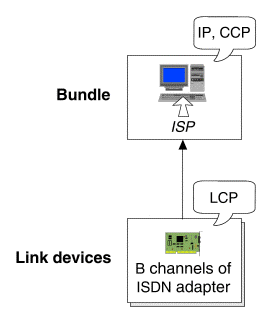
|
|
``An outgoing PPP configuration that uses an ISDN adapter'' shows the bundle and link devices that would be used to configure an outgoing PPP connection via the B channel of an ISDN terminal adapter to an Internet Service Provider (ISP). (The remote system could equally well be the remote access server of an organization in which high-speed connections form a vital part of its corporate intranet.)

An outgoing PPP configuration that uses an ISDN adapter
If the service provider allows multilink PPP access, the bundle can be configured to use both B channels of the ISDN adapter to increase the effective bandwidth of the link. If bandwidth-on-demand is configured, the second channel will only be added to the link if the amount of network traffic requires this. This is useful if you want to limit connection charges. If you expect to be downloading large amounts of data on a regular basis, you may want to configure a higher minimum number of devices in the multilink. In this example, the minimum could be set equal to the maximum value of 2. If multilink PPP is not available, only one channel can be used for the link.
In this instance, the bundle is configured to use the IP network protocol and the Compression Control Protocol (CCP).
CCP is not recommended for use with devices such as modems which provide hardware compression.
CCP will also increase the load on the CPU by requiring it to compress and uncompress data.
The remote access server may use one or more of the following methods to authenticate the incoming user before it will set up the PPP link: